And again, the reason I'd wanted to go here was to see part of the earliest history of the region, the first route pioneered to connect the western coast/fijords area with the interior... here's a description from the "Discover Patagonia" website:
[http://www.patagoniapordescubrir.com/articulos/?task=view&id=100], "The Salton was discovered in 1898 in an expedition of German geographer Hans Steffen, who ascended the Baker River from its mouth in Tortel, to its source in Bertrand Lake. In front of the Salton, you’ll observe a large rock outcropping with cut-outs, called Paso San Carlos. Anthropologist Mauricio Osorio Pefaur writes regarding its construction: "... built in the summer of 1901 as part of a project mandated by the Chilean government, in the area of the Baker River basin [1900-1901], with the goal of opening a path for communication and passage between the mouth of the Baker River, at the Fiords of the Pacific, and the Steppe areas in the east of the Region. The challenge was undertaken by a team of Chilean road builders and miners, under the leadership of Engineer Richard Michell.
In 1921, work began anew in this area; this time undertaken by a team of workers under the leadership of the general manager of the Posadas, Hobbs & Co., Esteban Lucas Bridges. Bridges sought to improve the existing trail, which was, at that time, in a state of neglect, in order to facilitate mule traffic which would carry loads of wool from the "La Colonia" area of Estancia Baker to the fiords. "(Osorio, 2010, declaration brief for the Paso San Carlos National Monument, in the Saltón area of the Baker river).
Today the Paso San Carlos is listed as a National Historic Landmark."
Lucas Bridges figures largely in the history of Argentine Tierra del Fuego around Ushuaia, so there's another connection there for me too... neat to put some puzzle pieces together.
On arrival the scenery was fantastic... not a vegetatively pristine area as the access road has several small family farms all along it where they are raising sheep and cattle, but it's all along the side of a large tributary of the Rio Baker (Río Ñadis) with the same braided stream character (wide valley, flat gravel bed, steep mountain walls at the eventual sides)... Then a wide delta like area at the junction of the rivers where the farm, Fundo Los Cipréses a Los Ñadis, is. Gorgeous, fronting on a mountainside with glacier at the top
Some awesome old beech trees that survived the epoch of fires, and then the refugio, which was the coziest 'basic shelter' I could imagine. Dorm beds with duvets, hot water showers, and the best kitchen and wood stove...
The next day I set out on the hike with a map from the caretaker, basically following the river downstream along a simple two-track (which connects the two downriver neighbors with the outside world) towards a pinch point that you could see where ridges on either side of the river come down from the mountains on either side of the river... where the rapids/waterfall/El Saltón presumably was, and then finally the road ended at the last homestead and turned into a footpath... was somewhat of an adventure to find the 'local' route but it worked out and after a time I found the noise of rushing water getting louder and louder...
And suddenly I was standing above El Saltón, the reason why the cut in the canyon wall was necessary in the first place. The rapids and turbulent falls were unnavigable and the spot unpassable on shore so a passage was hacked and blasted out of the canyon wall high above the river. This photo was taken from inside the passage back upstream towards the Saltón... note this river is glacier-fed by many tributaries, thus the milky color from all the suspended glacial sediment...
And here are some views of the cut... from the approach, maybe you can just see the white posts of the guard barrier just below the tree branches in the upper third of the photo...
Closer...
And inside...
Neat to see some of the presumably original posts and iron reinforcements still there...
And then around the corner an actual tunnel!
Not more than a few meters long but still a hole in the rock. A few more...
So that was a neat part of the history of the area to experience. And also neat was that following the trail around the corner of the mountain, the vegetation changed into the typical wet forest stuff... Evidently that spot right there was a sort of climactic barrier for the local valley system, and I even saw the effect of it that day when there were clouds building on the other side of the mountain and threatening to spill over and 'ruin' my perfect (and rare!) sunny day... but the mountain held them at bay and I was able to walk in peace and sun and dryness all the four hours back 'home'.
And what a walk it was ... I wasn't paying half as much attention (or stopping to take photos) on the way what with paying more direct attention to route finding and how long it was taking so I would be sure to make it home before dark... but on the rerun the light was just stunning to set off the pasture grass and remaining old giants, standing sentinel in witness to their brethren that has fallen in the fires... the other side to that sadness is that if all the original forest was standing you wouldn't be able to see the amazing mountains and surrounding scenery...
And another poignant reminder of times past was this lovely homestead, still standing after who knows how many tens of years in the wet and cold, due to it being constructed of cypress wood, roof and side shingles to boot.
And just one more neat feature of the area... not a lot of hardware to be had and any iron like nails might well just rust out and fail before the cypress wood would... I'd been noticing the gates of the pastures are wholly wood, the turn post placed in a sort of wood saucer placed in the ground and capped again by a wood support, lots of dowels used... just a really interesting detail of the local tradition...
Plus there are lichens... :)
Last comments about the hike... I'd mentioned something before about dams... recently what used to be the Chilean national water company was privatized... which has actually by law turned over the water rights throughout the entire country into the hands of one privately held business... And as I understand and it, there is no law to protect the rights or access of any surface water in the country by any landholder or city or anyone... the business owns it all. Basic drinking water, irrigation water, whatever. Really hard to fathom.
One aspect of this is that the country is heavily mineral-resource dependent, with huge copper mines in the north. But the mining process is equally heavily water dependent, but they're in the desert where water resources are already stressed. And energy supply to the mines is an issue as well. So there was a plan in action to dam the country's two largest rivers to assist with the 'energy crisis'... and to the surprise of the industry, this plan was met with a huge amount of opposition... somehow the word had gotten round during the assessment phase and even though these rivers are remote and there aren't many people who would directly be affected by the dams (it's an extremely sparsely settled region compared to the north of the country) the mystique and integrity of Chilean Patagonia was perceived (and rightly so) to be under threat (besides the challenges of logistical and cost efficacy of transport for both electricity and water from this remote region north to where the resources are needed) and it seems that the backlash was completely unexpected... so the project is stalled for now.
Apparently many improprieties were discovered to have taken place during the regulatory process, some sort of rubber stamping or looking the other way... and the current president doesn't want to get involved so won't authorize the project, yet won't negate it either. I have heard repeatedly that there are ten rich families that basically control the destiny/economy of Chile... one saying goes that you are born in a hospital owned by one of the families and when you die you're buried in a cemetery owned by the same family. But in this instance, so far, the voice of the people has had a huge affect. Google "Patagonia Chilena Sin Represas" (Chilean Patagonia Without Dams) to find out more.
The other (majorly) relevant thing about this and partly why I know a bit about it is because one of the dams of the project is slated to be placed right at the pinch point of El Saltón and would create a lake exactly where I had walked and where the farm and Refugio are... hard to imagine that cultural treasure and the surrounding area and community affected and forever changed in that way.
In order to continue my journey north the plan was to start out early on a Sunday and walk the 7 miles to the road and catch the regular bus to Cochrane, but as has happened so many times on this trip, luck was with me and the family who owned the property had come down for the weekend and I found them at home after my hike when I went to retun the maps. They were heading home Sunday afternoon and offered to give me a lift to town... Which saved me schlepping all my gear and had the bonus of getting to tag along to a neighboring farm on the way... it was branding time and all of the neighbors help each other out with this long task.
Next afternoon I and my gear were added to the load of firewood and other provisions in the truck and went over to visit with Lilli and her daughter, as the dad and son had gone over first thing to assist with the branding. This place was puro campo, real Chilean working family farm... where I had been had a more upscale feel... Lilli first came to the area as a backpacker from Germany and ended up marrying a local boy, and their home and situation were definitely more on the level of comfort and convenience that we in the states or middle class in the cities here would find familiar... but the neighbors' home and infrastructure were definitely more rural, so it was really neat to see a different side to life in the 'neighborhood' so to speak.
The branding was taking place in a circular ring, one animal at a time would be let in, and then it would run around the ring until one of the guys (on foot) could get a lasso loop around two of its legs, get it down on the ground on one side, and then hold it still while the hot iron was run over from the fire to the animal by the dueño or owner of the farm, to make the brand.
Seemed a slow process, most of the lasso throws would miss but it didn't seem to trouble anyone... there is a well known saying in the area that those who hurry in Patagonia lose time :) I wasn't the one throwing either so easy for me to say! But I did get to help a bit... All the women/girls were positioned around the fire where the branding iron was roasting and when the next animal was ready the dueño would hustle over and one of the women would take the iron out is the fire and hand it through the fence to him... and one time he came over and the women for some reason were occupies and I was standing right there so handed it over myself. Then when he came back, I had observed the regular process of the thing was to burn the iron on a flat piece of fat the. Stick it back in the fire... and so that became I guess by default my job for the next several rounds. I'm not exactly sure of the utility of the fat sizzling part... but we asked and it was something to do with making the brand burn smoother, or cleaner or something. Just neat to be involved.
After it was all done, the women, as they do, retired to the kitchen, while the men, as they do, stayed outside to prepare the asado or open-fire barbeque. The kitchen was basically the central living area in the house centered around the wood burning flat top cooking stove (a bigger version of the kind that was in the Refugio) and we all sat down on the padded benches around the stove and after a fashion shared sopapillas (fried bread) and drank maté.
This is the iconic typical drink of the countryside in several South American countries, it's basically communal tea. There is a hollow gourd the size of a coffee up or smaller (or as here a small enameled tin cup is used) filled with the loose leaves of the hierba (or herb, which is bitter to most palates but it has some sort of stimulant that is reputed to be better in all aspects than black tea or coffee... more concentration, lessens fatigue, has antioxidants and an easier and longer lasting 'high' than caffeine), then the bombilla (a short metal straw) is placed in the cup and in the hierba in the manner that suits the one preparing the mate (woe betide the sipper who alters the placement of the bombilla-- well not so severe but its against custom so I hear), and then hot water (just before the boil) is poured over the herb.
The one preparing/hosting the maté tests out the set up, making sure the temperature of the water is correct (not too hot, enough flavor) and then proceeds to offer the maté (what you call the gourd or cup and also the event of preparing and sharing the tea) to each person in turn, receiving back the maté when the sipper has finished their go (usually just enough water in the maté for a couple of ful sips on the bombilla), then pouring in more water and offering it to the next person in the circle/room etc. you'll keep getting it handed to you in turn until you say 'gracias' while handing it back (always making sure to hand back the maté with the bombilla pointing towards the host as a sign of respect/courtesy) which to signifies you're finished and don't wish to drink any more.
The neat thing about this round of maté was that the dueña used dried mint in the mix with the hierba, plus a small spoonful of sugar for each turn... there is a wide variety of hierba maté mixes to be found in the supermarkets, some that advertise 'suave' or smooth, some with mixed herbs... some folks like it less bitter or with other flavors... and so apparently in this household, they liked it sweet or perhaps because there were two 'less hardy souls' present (Lilli and my clearly foreigner self) she added sugar... I like the bitter taste so it's not a big deal for me but the combo of mint and sweet with the maté was really wonderful and shared in such a manner, around an old, well-used stove, with babies and kids and moms talking about what they talk about... was just really cool.
And that's that. Up to town (we left before the asado was served, too bad!), got in late, Lilli generously offered to put me up for the night since it was so late and then ended up driving me around the village the next morning in search of the bus company that was supposedly going to Coyhaique, a center of activity further north... and we found it thanks to her efforts... a wonderful family and great experience to have and share in deep Patagonia.
Next up, emerging from the campo...


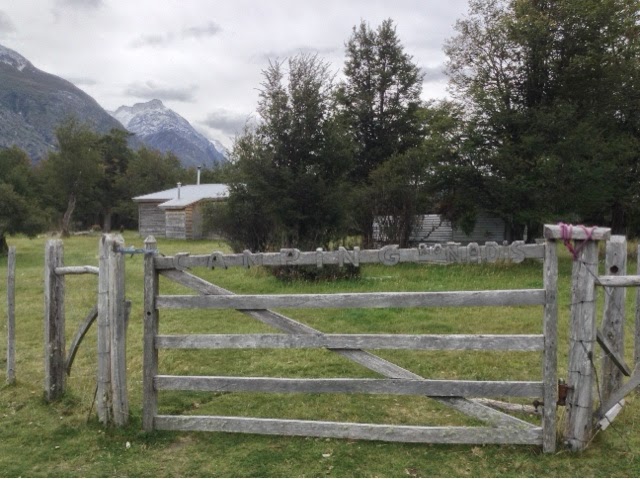
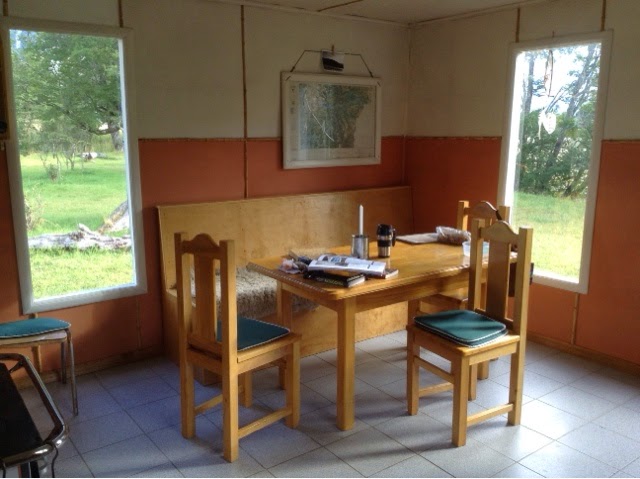

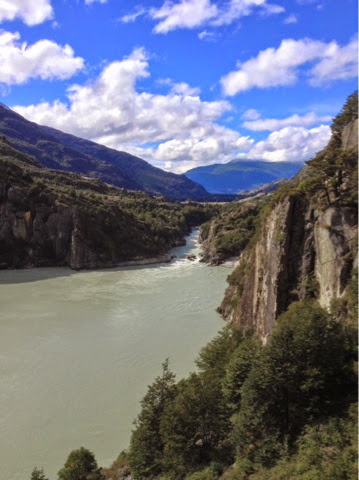
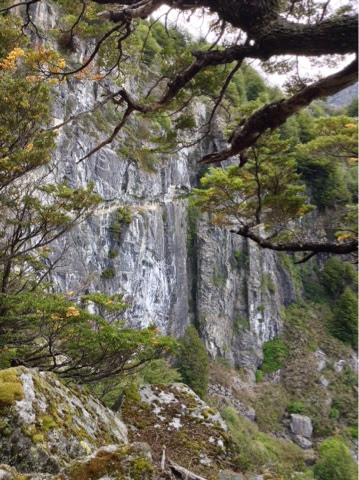
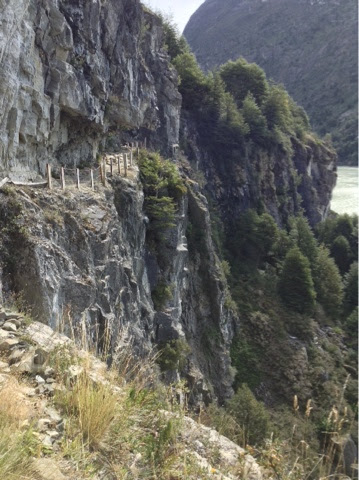
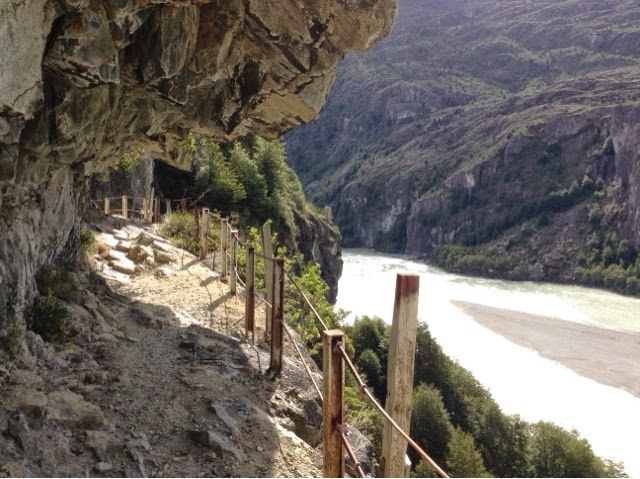


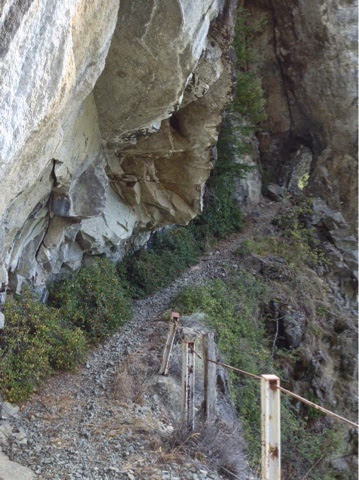





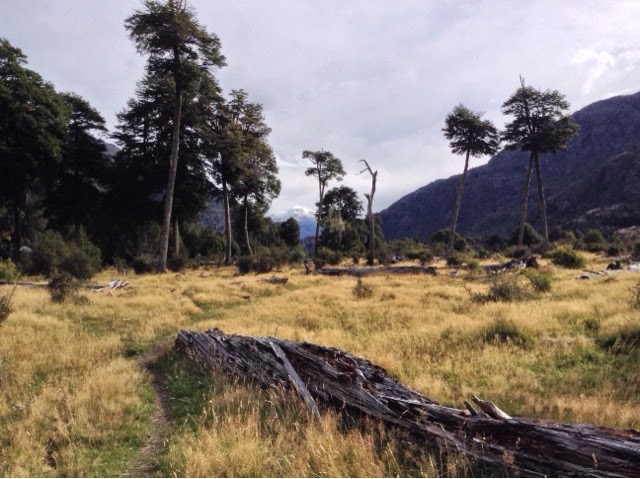
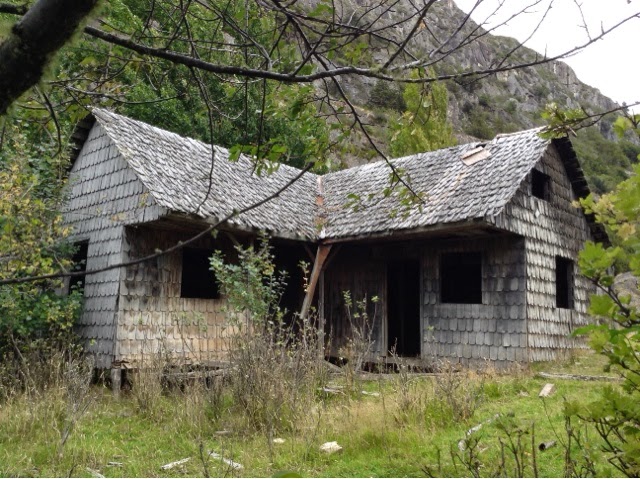

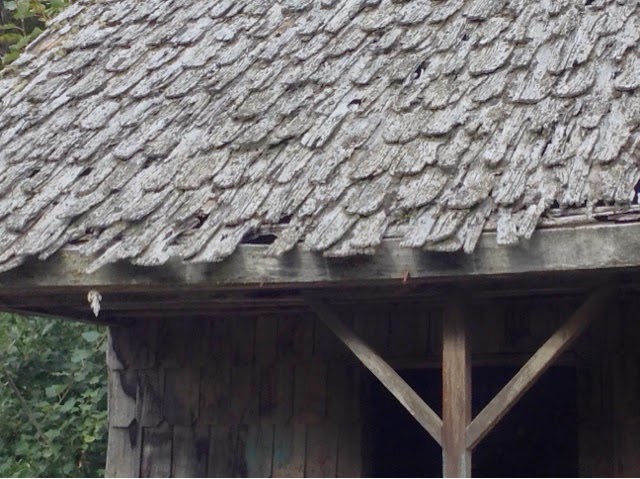







As always: wow. That walk along the cut looks amazing! You keep giving me things to add to my TODO list in Chile - I'm never going to be able to do them all in this lifetime.
ReplyDeleteA couple of years back I got to attend a northern California version of the sort of branding you saw. But wasn't brave enough to dive in and lend a hand. Among the best BBQ I can remember having, though.
Thanks, as always, for sharing your travels with us!